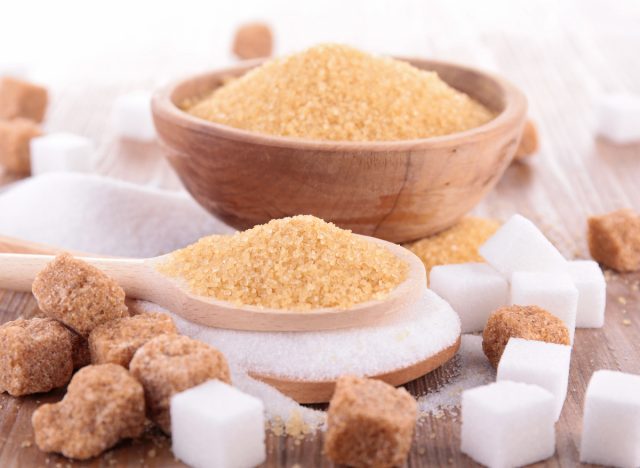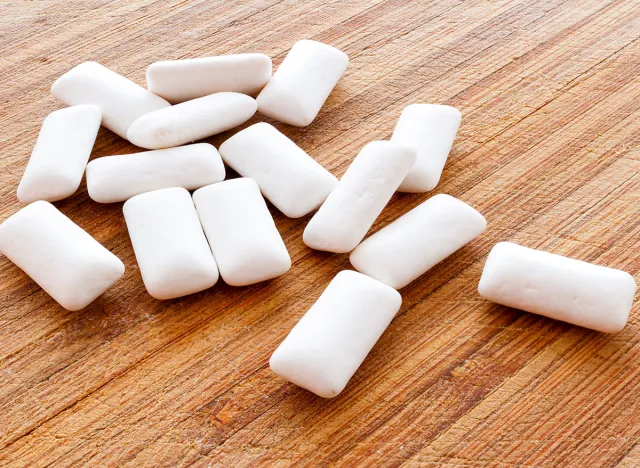
High fructose corn syrup (HFCS) is a common sweetener used in a wide range of drinks and food. From soda and juice to candy, sauces, and crackers, there is no shortage of HFCS in our food supply. You have likely heard of this ingredient and that is because of the bad reputation it has garnered over recent years. Research suggests this ingredient may increase your risk of metabolic and glucose dysregulation as well as obesity. With outcomes as serious as these, experts recommend monitoring your intake of added sugar, including HFCS.
This ingredient isn't the only one with potential health risks. In fact, you may be surprised how many of your favorite foods contain questionable ingredients such as food dyes and colorings, artificial sweeteners, and certain forms of oil. While these ingredients may not benefit your health, food manufacturers use them for a variety of reasons. Some can extend the shelf life of food, others enhance flavor, and some aid in cheaper manufacturing costs.
These outcomes may benefit the manufacturer, but you are better off skipping them. If you are wanting to improve your food selections for your health, there are a few easy rules to follow. First, limit your intake of processed foods. This includes items like cereal, crackers, bread, sweets, and deli meats, just to name a few. You should also swap your sweetened drinks, whether made with sugar or a substitute, for water or other unsweetened beverages. If you can follow these suggestions while increasing your intake of fruits and vegetables, lean protein, and minimally processed whole grains, you're on your way to protecting your health.
When in doubt, you should avoid the following ingredients if you see them on a food package. Here are 12 ingredients worse than high fructose corn syrup. Read on, and for more, don't miss 12 Ice Cream Brands That Use the Lowest Quality Ingredients.
Partially Hydrogenated Oil

In 2018, the U.S. Food and Drug Administration (FDA) determined that partially hydrogenated oils (PHOs) fats were no longer "generally regarded as safe," and ordered manufacturers to discontinue using them. However, you may still find them in products that were part of a manufacturing process that began before the FDA assigned a cut-off date.
Vegetable shortening, bakery items, microwaveable popcorn, and frosting name some foods that may PHOs. Manufacturers use this in place of butter and lard as a cheaper alternative that can extend shelf life, and enhance the flavor and texture of foods. However, this ingredient can also add trans fat to your food that are linked to negative health outcomes, like cardiovascular disease (CVD), weight gain, and diabetes.
Your body does not need trans fat, so you should eat as little as possible. Eventually, you may not be able to find PHOs in your favorite snacks, but for now, you should remain on the lookout.
Aspartame

This sugar substitute is 180-200 times sweeter than sucrose—table sugar—and was developed as a sugar substitute. Although it is used in a wide range of beverages and "diet" products, it remains a controversial ingredient. Studies suggest there may be a link between aspartame consumption and the development of diabetes, and this ingredient may also influence obesity, glucose and insulin intolerance, and changes in the gut microbiota.
Mood disorders and depression may also be caused by aspartame. While some of this research has only been documented in animals, other studies have documented negative outcomes in humans. There is enough negative research surrounding the use of aspartame to limit your consumption. Instead of aspartame-sweetened drinks, try safer zero-calorie sweeteners, like stevia and monk fruit.
Sodium Nitrite

This common food preservative is most often found in processed and cured meats, like deli meat and jerky. Although sodium nitrite is considered to be safe for human consumption, this ingredient has been linked to an increased risk of cancer development. It is important to note this is true for synthetic sodium nitrite used in processed foods, and not for naturally occurring nitrates.
Many vegetables contain nitrates that convert to nitrites in the body. However, these vegetables do not contain heme iron and are natural sources of antioxidants, like vitamins C and E, that keep these veggies from posing the same health risks of sodium nitrite in your processed meats. Many manufacturers are now making deli meat and other products free from nitrites, making it easier to avoid this ingredient in your common foods.
Red No. 3

This coloring is one that is currently used in food products, but it has been banned from being used in cosmetics due to negative health outcomes. However, this is concerning considering one study conducted in rats found those administered red no. 3 had a higher incidence of thyroid tumors.
Many food dyes and colorings have been found to be associated with negative outcomes in research. These products are used to create an appealing aesthetic in food and drinks, but it may be at the cost of your health. You'll find red dye no. 3 and other colorings in processed food and drinks, giving you one more reason to reduce your intake of packaged and processed items.
Caramel Coloring

You'll find this coloring most often in soda and candy, and sometimes in beer and baked goods. Ammonia is often used in the production of caramel coloring, leading it to contain contaminates that have been found to cause cancer in mice. Unfortunately, this ingredient can be lurking in unassuming places, like frozen dinners and lunch meat, so spend time reviewing ingredient lists to ensure you purchase products without this concerning coloring.
Titanium Dioxide

The bright white coloring of your yogurt, marshmallow, milk, and more could be from this ingredient. Titanium dioxide is used as a whitening agent in food and cosmetics, but some research suggests this additive is carcinogenic. In fact, the International Agency for Research on Cancer (IARC) lists Titanium Dioxide as a 2B carcinogen which defines it as "possibly carcinogenic to humans."
While this classification is specific to inhaled titanium dioxide, other research suggests titanium dioxide may be linked to inflammation and neurotoxicity when used as a food additive.
BHA & BHT

Also known as butylated hydroxyanisole and butylated hydroxytoluene, these ingredients are added to processed foods as preservatives. Crackers, cereal, and other snack foods with added fat are the most common sources of BHA and BHT. The FDA categorizes both of these ingredients as safe up to a certain amount; however, animal studies suggest BHA could increase cancer risk in humans. Other bodies of research suggest BHA and BHT could potentially disrupt sex hormones. Many manufacturers are now using vitamin E as a more natural alternative to questionable BHA and BHT.
Tertiary Butylhydroquinone (TBHQ)

More commonly known as TBHQ, this additive is used to preserve food and is often added in conjunction with BHA and BHT. The Center for Science in the Public Interest (CSPI) suggests consumers avoid this ingredient as one study found TBHQ increased the incidence of tumors in rats. Similar to other preservatives, you'll find TBHQ in snack foods, cereals, and other processed items with added fat.
Brominated Vegetable Oil

An ingredient used less and less over the last decade, brominated vegetable oil (BVO) has been used as an emulsifier and clouding agent in soda and sports drinks. While many manufacturers have decided to forego this ingredient, some popular beverages, like Sun Drop, still contain BVO.
The CSPI recommends complete avoidance of this ingredient as research has documented cases of heart lesions, fatty changes in the liver, and impaired growth and behavioral development. In Europe, BVO is banned as a food additive while it has maintained "interim" status on the FDA's Generally Regarded as Safe list since 1970.
Evaporated Cane Juice

While evaporated cane juice may have a more unassuming name than sugar or HFCS, there is not much nutritional difference. Just like other forms of sugar, if consumed in excess, evaporated cane juice may increase your risk of weight gain, type 2 diabetes, and CVD. Added sugar in all forms should be limited to 25 grams per day for women and 36 grams per day for men, according to The American Heart Association.
Sodium Phosphate

The combination of sodium and phosphate is used as a food additive with many functions. Sodium phosphate can help keep meat products moist, serve as a leavening agent in cake mixes, and is an emulsifying agent in processed cheeses. Although sodium and phosphate are essential nutrients, high consumption can lead to health complications. When it comes to high levels of phosphate, like those seen when it is used as a food additive, research has noted an increase in mortality rates, and accelerated aging and vascular damage.
Propyl Gallate

Perhaps one of the lesser-known ingredients on this list, propyl gallate is another ingredient the CSPI has tagged with the "avoid" recommendation. This ingredient is also commonly used with BHA and BHT because of the synergistic preservative effects. Research suggests this ingredient may be an endocrine disruptor and carcinogen. One government study actually noted propyl gallate caused more cancer in rats treated with low doses of this ingredient than groups that were given a zero dose or high dose. This unusual outcome gives reason to avoid this ingredient. According to CSPI, you can find propyl gallate in vegetable oil, meat products, and chewing gum amongst other items.
- Source: https://www.ncbi.nlm.nih.gov/pmc/articles/PMC5747444/
- Source: https://medlineplus.gov/ency/patientinstructions/000786.htm
- Source: https://www.ncbi.nlm.nih.gov/pmc/articles/PMC8227014/
- Source: https://www.ncbi.nlm.nih.gov/pmc/articles/PMC6893523/
- Source: https://www.fda.gov/industry/color-additive-inventories/color-additive-status-list
- Source: https://pubmed.ncbi.nlm.nih.gov/2824305/
- Source: https://www.cspinet.org/article/caramel-coloring
- Source: https://publications.iarc.fr/111
- Source: https://efsa.onlinelibrary.wiley.com/doi/10.2903/j.efsa.2021.6585
- Source: https://ntp.niehs.nih.gov/sites/default/files/ntp/roc/content/profiles/butylatedhydroxyanisole.pdf
- Source: https://www.sciencedirect.com/science/article/abs/pii/S0300483X04006079?via%3Dihub
- Source: https://www.cspinet.org/article/tbhq-tert-butylhydroquinone
- Source: https://www.cspinet.org/article/brominated-vegetable-oil-bvo
- Source: https://pubmed.ncbi.nlm.nih.gov/33855443/
- Source: https://www.heart.org/en/healthy-living/healthy-eating/eat-smart/sugar/how-much-sugar-is-too-much
- Source: https://www.ncbi.nlm.nih.gov/pmc/articles/PMC3278747/
- Source: https://www.cspinet.org/article/propyl-gallate









